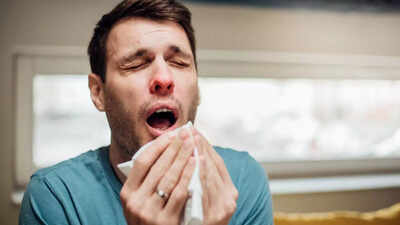ARTICLE AD BOX

We have all had those sneezing fits that come out of nowhere. One sneeze turns into five, and before you know it, your nose will not stop reacting. While most people blame allergies, that is not always the case.
Sometimes, sneezing happens because your nose is irritated by dust, smoke, perfume, or even temperature changes. According to a peer-reviewed study published in Frontiers in Allergy, sneezing is a protective reflex that helps clear irritants and allergens from the nasal passages. The challenge is identifying whether your sneezes are caused by an allergic reaction or simply environmental irritation. Understanding this difference can help you manage symptoms better and know when to see a doctor.
How sneezing works and what triggers the sneeze reflex
Sneezing begins when your nasal lining detects something that should not be there, such as pollen, dust, smoke, or strong odours. The brain immediately sends a signal to the chest and throat muscles to contract, forcing air out at a high speed to expel the irritant.When an allergy is involved, your immune system reacts to harmless particles like pollen or pet dander, releasing histamine. This causes swelling, itching, and increased mucus.
In contrast, an irritant-driven sneeze does not involve the immune system. It is simply a mechanical response to remove whatever is bothering your nose.
How to tell if sneezing fits are caused by allergies or irritants
It can be tricky to tell whether your sneezing fits come from allergies or environmental irritants. However, there are a few ways to distinguish between the two.
- Allergy sneezing: Often appears with watery eyes, itching, nasal congestion and seasonal patterns, particularly during spring and autumn.
- Irritant sneezing: Triggered by smoke, pollution, perfumes, or cleaning sprays. It tends to stop when exposure ends.
- Mixed sneezing: Many people experience both, especially in urban areas where pollen levels and particulate matter (PM2.5 and PM10) are high.
Keeping track of your symptoms in a diary, along with weather conditions and indoor activities, can help identify patterns and triggers.
At-home tips to manage pollen and particulate matter sneezing
Managing environmental triggers is one of the most effective ways to reduce sneezing fits. Here are some practical steps to follow.
- Check air quality and pollen forecasts daily. Limit outdoor activity when counts are high.
- Keep windows closed during high-pollen hours in the morning and evening.
- Use an air purifier with a HEPA filter to reduce dust and particulate matter indoors.
- Wash your hands and face after spending time outdoors to remove pollen particles.
- Avoid burning candles, incense or using aerosol sprays that add irritants to the air.
- Change clothes and shower after returning home to keep allergens out of your bed.
These small daily habits can make a noticeable difference during allergy or pollution-heavy seasons.
How to use a saline rinse to relieve sneezing caused by allergies or irritants
A saline rinse is one of the simplest ways to reduce nasal irritation. It helps flush out dust, pollen, mucus and pollutants that build up in the nose. You can use a pre-mixed saline spray or make your own using distilled or boiled water with salt.Using a nasal rinse once or twice a day keeps the nasal lining clean, moist and less sensitive to allergens and irritants. It is also safe for long-term use and suitable for people who prefer to avoid medication. Regular rinsing can prevent recurring sneezing fits and reduce nasal dryness from air pollution.
When sneezing fits might be a sign of something more serious
Although most sneezing is harmless, certain symptoms suggest that medical attention may be necessary.
- Persistent sneezing for more than two weeks without improvement
- Wheezing, shortness of breath or tightness in the chest
- Fever, chills or general fatigue, which may indicate infection
- Discoloured or bloody mucus and facial pain
- Sudden sneezing accompanied by swelling around the eyes or lips
If you notice these red flags, consult a doctor to rule out respiratory infections, severe allergies or other underlying conditions.
Healthy daily habits to reduce allergy and irritant sneezing
Simple lifestyle changes can reduce the frequency and severity of sneezing fits.
- Keep your home dust-free by vacuuming weekly with a HEPA filter.
- Replace air conditioner filters regularly.
- Stay hydrated to maintain nasal moisture.
- Eat foods rich in antioxidants and natural antihistamines such as citrus fruits, turmeric and green tea.
- Get enough sleep to support a healthy immune response.
Consistency is key. These small steps create a cleaner indoor environment and strengthen your body’s defences against allergens and irritants.Sneezing is your body’s natural way of protecting itself, but frequent sneezing can signal that something in your environment is triggering irritation. If sneezing occurs briefly after exposure to dust or smoke, it is likely a mild irritant reaction.
If it comes with itching, watery eyes or congestion that lasts for days, it could be an allergy.By maintaining clean air indoors, using a saline rinse and paying attention to red flags such as wheezing or fever, you can manage sneezing more effectively. The key is to observe your body’s signals and take simple, consistent steps to keep both allergens and irritants at bay.Disclaimer: This article is for general informational purposes only and is not a substitute for professional medical advice, diagnosis, or treatment. Always seek the guidance of a qualified healthcare provider regarding any medical condition or lifestyle change.Also read| How often should you poop? Understanding what’s normal for your bowel health

 1 hour ago
4
1 hour ago
4








 English (US) ·
English (US) ·